
If you own a WordPress site, you probably already know how important it is to make it fast and reliable. Slow loading speeds and poor website performance will rather discourage visitors to remain on your site and lead to a high bounce rate. One solution to this problem is to use a Content Delivery Network (CDN) for your site. A WordPress CDN can help improve website performance by reducing load times and ensuring faster content delivery.
As WordPress sites can be quite media-intensive, CDN services nowadays are considered a staple in the WordPress world because of their impact on performance. Thus, it is important to know what CDN is, why and when you should use one, and how you can quickly set one up with just one click, using Pressidium’s WordPress CDN integration.
So let’s dig in!
What is a CDN?
A Content Delivery Network, CDN for short, is a distributed network of servers dispersed around the globe. These servers are designed to host and serve cached static content (images, videos, JavaScript, and CSS) that is retrieved from the origin server where the website lives. Then, when a user requests this content, it is served quickly and efficiently from the nearest possible CDN distribution location.
How Do CDN Requests Work?
When you request a page from your CDN-enabled site, the static assets are served by the CDN network. The network chooses a CDN server that’s closest to your geographical location and serves the assets from there. For example, if a visitor from Europe visits your website that is located in North America, the content will be delivered by a CDN server that is located in Europe.
When a CDN server doesn’t have the asset that’s requested, it fetches it from the “origin” server -where your website is hosted- and caches it. This means that in every future request for the same content, the CDN edge server will serve the cached, ready content, saving a lot of time from reaching the origin server again.
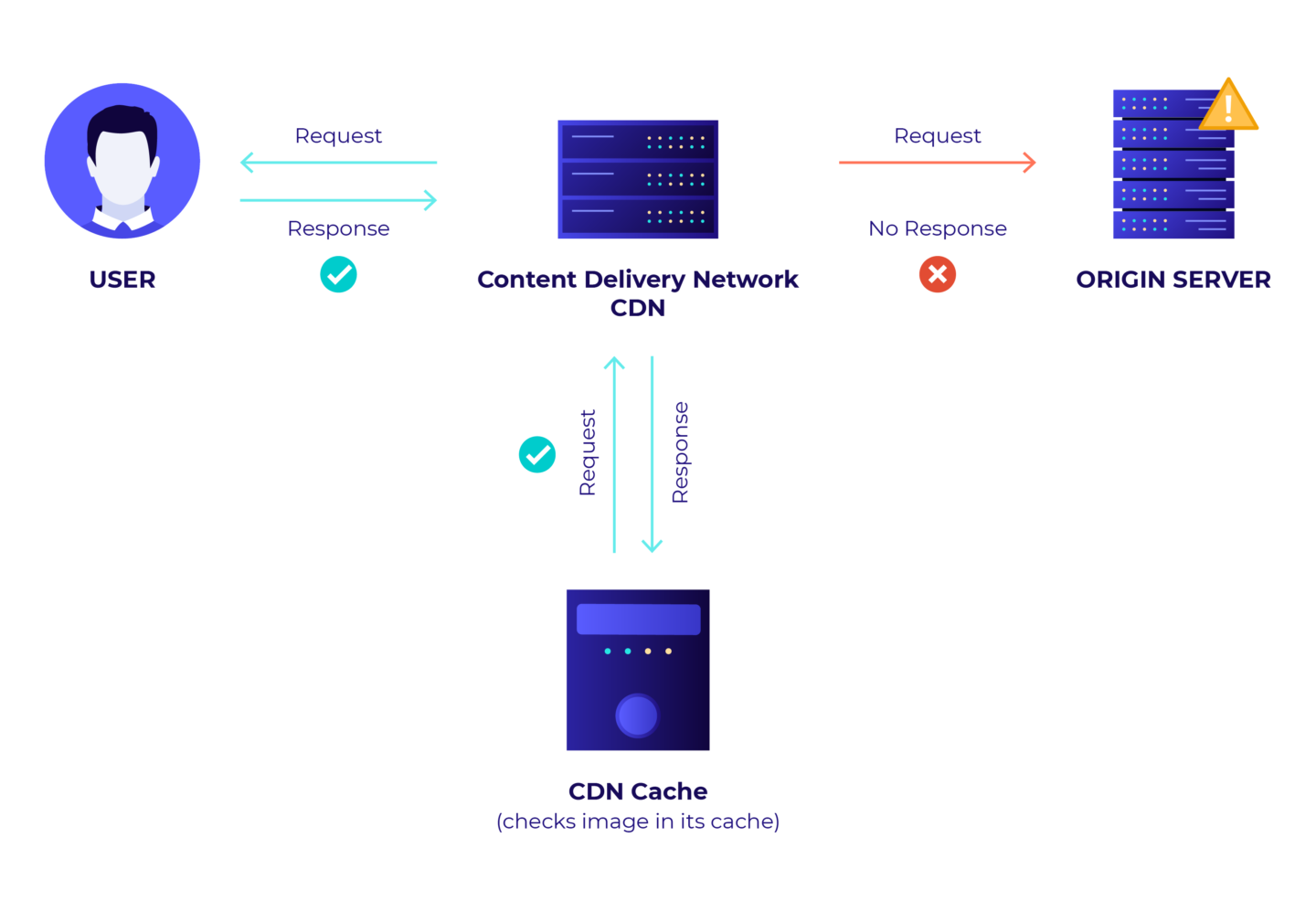
And this is how the distribution would apply without the CDN technology.
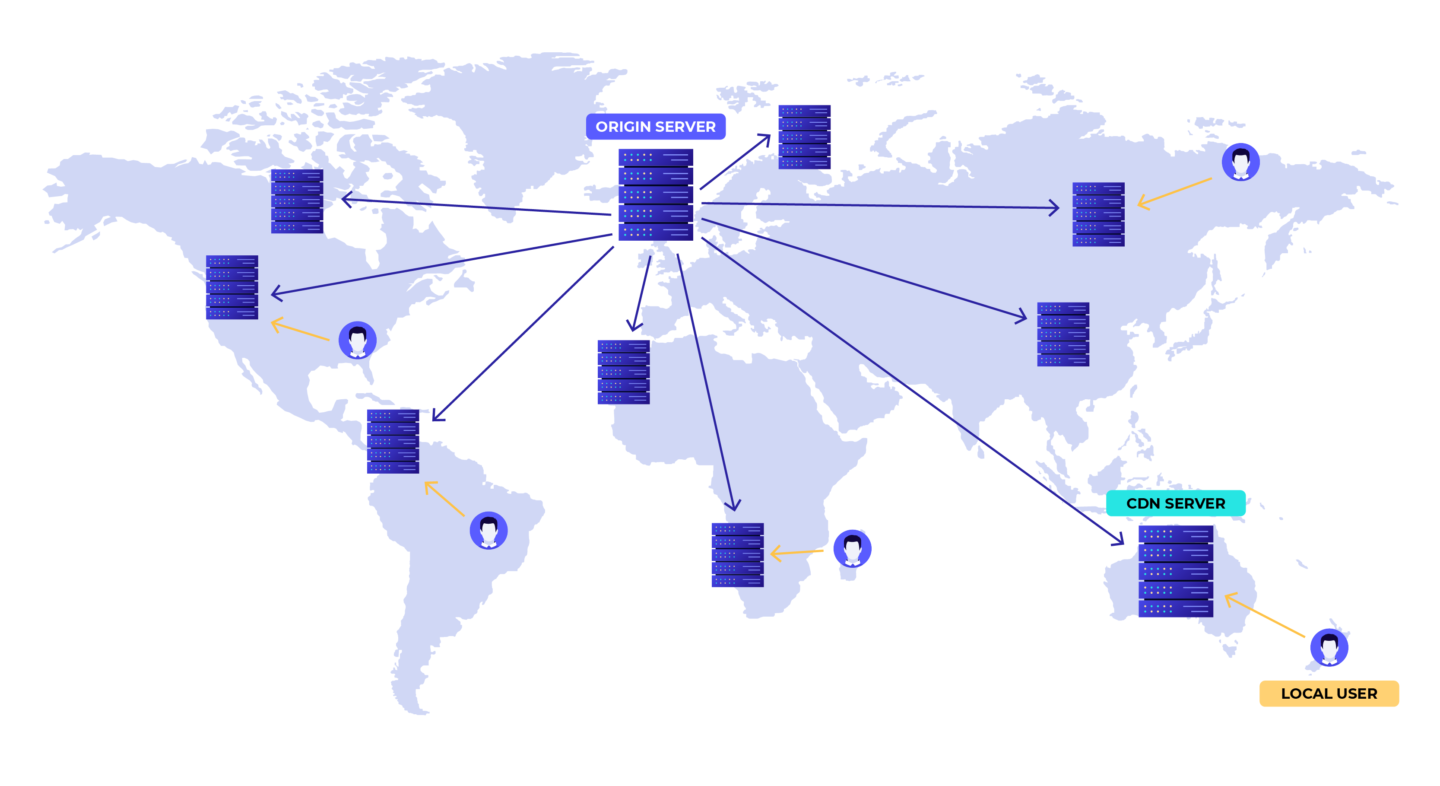
NOTE: Don’t confuse the CDN service with your hosting provider. A CDN service can’t run your PHP files, it only stores and serves the static assets of your website.
The Push/Pull CDN Configuration
The above distribution is accomplished with the help of the push and the pull configurations.
The Push CDN configuration involves the CDN provider receiving the website’s content from the origin server and then storing and distributing it to its network of edge servers without waiting for requests from end-users. This method is called “push” because the website’s content is pushed from the origin server to the CDN edge servers.
On the other hand, pull CDN configuration requires the CDN provider to wait for user requests before fetching the content from the origin server and delivering it to the user from the nearest edge server. This method is called “pull” because the CDN edge servers pull the website’s content from the origin server only when a user requests it.
In summary, push CDN configuration preloads the content onto the CDN edge servers, while pull CDN configuration retrieves content from the origin server when needed. Both methods have their pros and cons, and the choice between them depends on factors such as website traffic, user location, and content updates.
The Benefits of CDN for WordPress Performance
Overall, a CDN is a powerful tool for improving website performance and reliability. It improves website loading times and can reduce server load and bandwidth usage of high-traffic websites. A CDN can also reduce the risk of server downtime or crashes and offer protection against DDoS attacks.
Let’s break down the CDN benefits and see how it can improve your WordPress performance.
CDN Improves Page Loading Speed
A CDN distributes website content to your visitors across multiple servers in different geographical locations. The CDN servers are strategically placed in high-traffic areas to facilitate the quickest possible traffic flow. Since the content of your website is delivered by servers that are geographically closer, network latency is minimized resulting in faster content loading.
NOTE: Network latency refers to the amount of time consumed for the data to travel from its source to its destination across a network. Reduced network latency results in smaller TTFB (Time To First Byte).
Besides network latency and the reduced TTFB, CDN servers also provide several speed-related features that can further improve performance. Such are caching, HTTP/2 support, compression, reducing the number of requests, and control of browser-related caching using HTTP headers. The difference in load times is significant and depends on several factors like the website’s content, the user’s location, and the size of the website.
CDN Performance Comparison
Trying to demonstrate the CDN impact on loading speed, we ran some tests on the simple case of distributing one single file with and without CDN. We came up with the results below that show the variation in loading times across different request locations:
Akamai CDN:
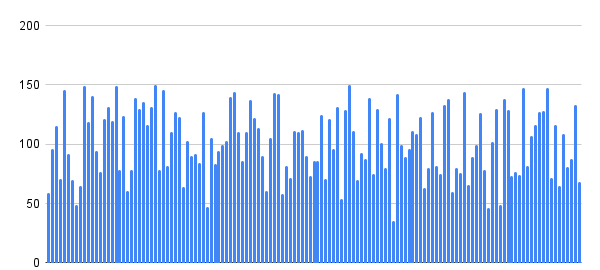
BunnyCDN:
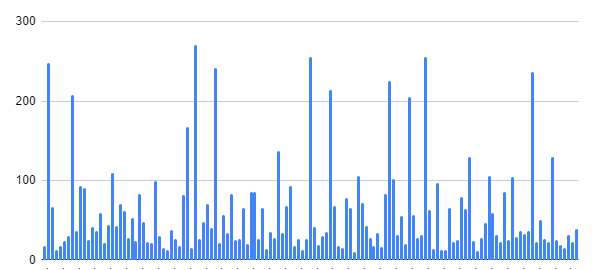
KeyCDN:

CacheFly:

CloudflareCDN:


CDN77:

All providers scored a 100% uptime. Here is a comparison based on the average response times and 90th percentile:
NOTE: The 90th percentile represents the value below which 90% of the response times are found.

According to the HTTP Archive 2023 reports,
- 51.4% of mobile pages take longer than 3 seconds to load
- the average loading time for mobile pages is 7.7 seconds.
Also, the bounce rate increases significantly as page load times increase. Specifically,
- the bounce rate for mobile sites with a load time of 1 second or less is 12.8%, but
- this rate jumps to 41.2% for mobile sites with a load time of 5 seconds or more.
A significant percentage of users are likely to abandon a site if it takes longer than 3 seconds to load, with bounce rates increasing sharply for sites that take 5 seconds or more.
Also, during the last Cyber Monday holiday, Akamai analyzed global mobile session traffic and calculated the peak conversion rate of 4.75% was reached when the page load time was 3.3 seconds. A one-second increase brought the conversion rate down to 3.52%, a 26% drop.
CDN Improves the Uptime and Availability of Your WordPress Site
A CDN service also contributes to your site’s uptime and availability. When using CDN, apart from just images and files, you can serve an HTML version of your website. Having said that, if the server that hosts your website experiences downtime, your website content will be still distributed via CDN. This ensures that no matter what, your website will remain available.
NOTE: It is important to point out here that this is not a default functionality of a CDN network and is not necessarily included in any CDN provider’s features
This is also the way CDN helps with sudden traffic spikes. A common case is when you go viral, or launch a new product and get an influx of visits and new users. In such cases, your website won’t suffer by trying to serve content to everyone. Visitors will be served by the corresponding CDN edge server at their location, and your website will stay online.
CDN Enhances Your WordPress SEO
Despite the lack of proof in this statement, there are suggestions that using CDN will consequently improve your SEO as well.
In theory, it is valid, as it is based on the CDN’s impact on user experience. Distributing your resources via CDN, allows users to see the fastest possible version of your website from any location. This is known as a factor that affects ranking, along with the low bounce rates we mentioned before. So, as a result of the improved performance with the use of a CDN service, your website will be likely looked upon favorably by Google.
Understanding the benefits of a CDN is crucial for optimizing your WordPress site’s performance. If you’re curious about how well your current setup is performing or if there are areas for improvement, our free performance audit is a great next step. Click the banner below to get started!

Choosing the Right CDN Provider for Your WordPress Performance
With so many CDN providers available, it can be difficult to know where to start when looking for the right one for you. So let’s point out some important criteria that you should consider when choosing a CDN provider.
Scalability
Does the CDN provider offer any scalability? As your traffic grows, you should be able to upgrade your plan easily and quickly in case it needs to accommodate your growth.
You should be able to upgrade your plan quickly and easily. You should be able to choose from a variety of options that can be changed to fit different levels of traffic.
In such cases, many providers offer a pay-as-you-go payment model, which is considered a good practice. This allows you to pay only for the resources you use and can help you save money on unused resources.
Geographic Reach and Number of POPs (Points Of Presence)
You should look for a CDN provider with a large number of POPs in different parts of the world and a wide geographic reach, especially if your website is read by people from all over the world.
The more “points of presence” (PoPs) a content delivery network (CDN) has in different regions and countries around the world, the more likely it is that your website’s content will be cached and sent from a server close to the user’s location.
This will help make sure that your website’s content is cached and sent from a server closer to the user, making your website load faster and giving the user a better experience.
Speed and Performance
Another thing that helps the CDN provider deliver content quickly and efficiently is the speed and performance practices it uses.
The caching options, like dynamic content caching, edge caching, and origin caching, can improve website performance and reduce server load.
Image optimization, JavaScript minification, and support for HTTP/2 are some other features that may help as well.
Reliability and Uptime
Reliability and uptime are two of the most important things when it comes to choosing a CDN provider. A good history activity indicates a great chance that your website will not go down because of CDN problems.
Around this specification, look for providers that offer a service level agreement (SLA) that guarantees a certain level of uptime, as well as a monitoring system that detects and resolves issues quickly.
Luckily, you can see some results regarding CDN uptime with the help of services like CDNPerf:
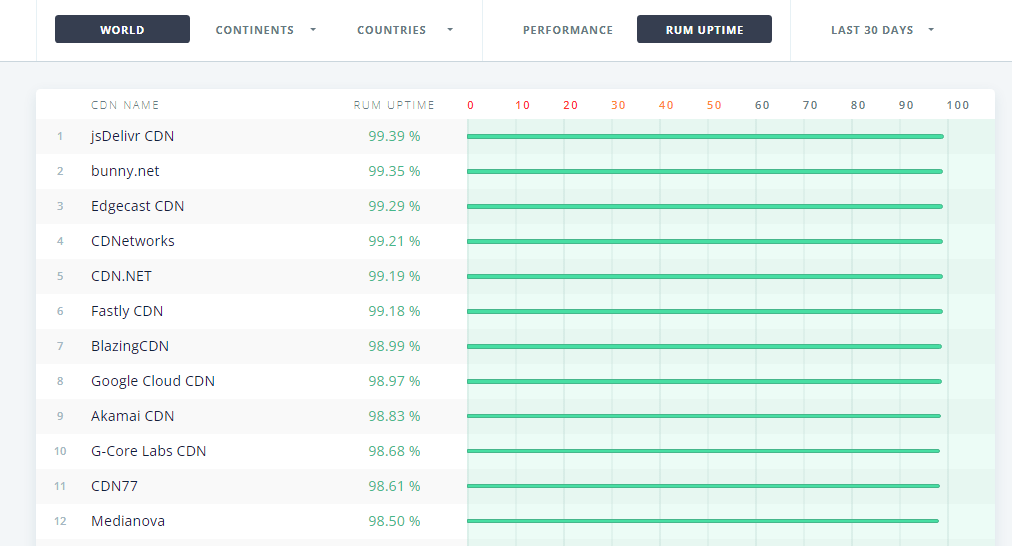
In the example above, you can see the uptime stats of various CDN providers in North America for the last month.
Security
When picking a CDN provider for your website, it’s important to look at the security features it has and make sure they fit your needs. Those features can protect your content from unauthorized access, cyberattacks, and other security threats.
A CDN can offer SSL/TLS to make sure all data is encrypted and safe, as well as protection from DDoS (Distributed Denial of Service) attacks.
They might also offer a web application firewall (WAF), bot detection and mitigation, IP blocking, and content access control.
Another popular security feature CDN providers include is the Origin Shield. This feature helps protect the origin server from receiving too much traffic during sudden spikes in demand. In such cases, Akamai CDN for example, reduces the requests to your origin by side-pulling new content from a shielded PoP close to your origin.
Do not hesitate to ask CDN provider’s support about how often the data is cached or if their server security is being tested and checked.
Cost
CDN providers charge for their services in a variety of ways, with costs varying based on the amount of data transferred, geographic location, required features, and more.
The two most common options are pay-as-you-go and monthly subscription plans.
Pay-as-you-go plans assess fees based on the quantity of data transferred or the number of CDN requests. This is suitable for websites with seasonal traffic spikes. However, it is impossible to predict costs precisely, and unexpected traffic surges can result in increased fees.
For websites with more consistent traffic, the monthly plans suit better, as they charge the same amount no matter how much data is sent or how many requests are made.
Here is a quick comparison of some of the most popular providers.
| CDN Provider | PoPs | Free Trial? | Starting Price (USD) |
|---|---|---|---|
| Akamai | 300+ | Yes | (Contact Sales) |
| Cloudflare | 155 | Yes | $20/month |
| BunnyCDN | 39 | 14 days | $1/month |
| KeyCDN | 34 | 14 days | $4.50/month |
| CDN77 | 33 | 14 days | $0.049/GB per month |
| CacheFly | 43 | 14 days | $295/month |
CDN Integration with WordPress
While keeping all of the above in mind, you should also choose a CDN provider that works well with WordPress. Whether it is a free CDN service or not, you should be able to connect it to WordPress using a WordPress and CDN integration plugin.
Some CDN providers, such as Sucuri, Akamai, KeyCDN, or Cloudflare, offer this feature. It makes setting up and managing the CDN easier without the need for technical knowledge or manual configuration.
Of course, it would be wise to first ensure that this plugin is compatible with your website’s theme and other plugins and has no conflicts or issues that can affect your website’s performance and functionality.
Compare WordPress CDN Providers’ Performance
CDN performance can be measured using different factors like uptime, response time, throughput, and error rates. Services like cdnperf.com can compare the performance of different providers based on these factors by collecting and analyzing data from real-world users.
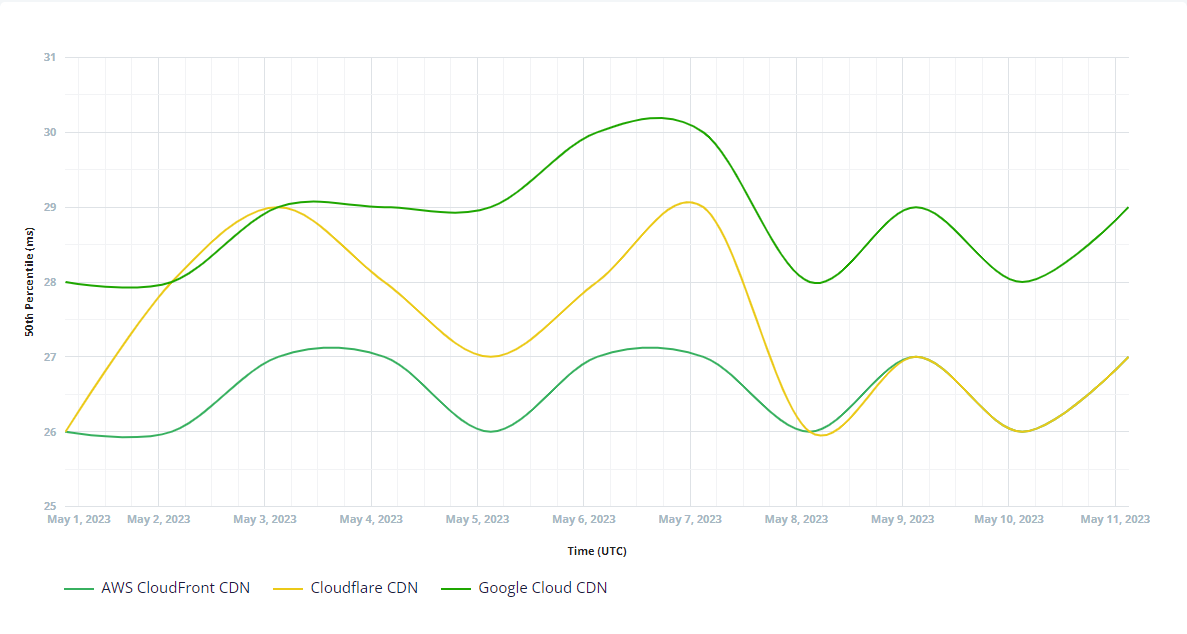
Above we see an example metric that compares the performance of three popular CDN providers: AWS CloudFront, Cloudflare, and Google Cloud for the time period since the 1st of May 2023.
More CDN Performance Factors
There are more factors that play a role when choosing a CDN provider but are not so easily available to the public because they are very technical. However, you can consider them when communicating with the providers.
Network capacity: The CDN provider should have sufficient capacity to manage the traffic on your website while still providing a service that is both quick and reliable.
Sufficient bandwidth: Bandwidth is the amount of data that can be transferred between the CDN provider’s servers and your website’s visitors.
Server capacity: Make sure that the CDN provider has enough servers for your website’s traffic and that they are located in different regions to reduce latency.
Network Infrastructure: The provider should have a well-designed and well-maintained network of servers and data centers with high-speed connections and low latency networks, as well as redundant systems with backup and failover mechanisms.
If you could arrange a stress test would be helpful to estimate the sufficiency of the above factors.
Pressidium WordPress CDN
At Pressidium we do things having you in mind. We spare you from the hustle of researching for, choosing, and setting up a separate WordPress CDN service by offering one for free on all plans! (except for the Micro).
Pressidium® has recently partnered with Akamai CDN, and will now be offering Akamai Enterprise CDN with no change in our current CDN pricing to all of our customers, effective immediately.
Akamai’s Enterprise Content Delivery Network operates worldwide with over 300+ PoPs in a bleeding-edge network of over approximately 365,000 servers deployed in more than 135 countries. It supports the new HTTP/2 protocol which implements superior multiplexing, raw binary data transfer, header compression, and much more.
Furthermore, it is built on SSD storage, and it is integrated with our own Pressidium caching layer. WordPress developers will also find a nifty feature that allows them to invalidate the cache on demand, and serve different versions of the same content. By using URLs with parameters such as ?v=1.2, these requests are treated as separate cacheable content! On top of that, setting up a CDN with Pressidium is incredibly easy with just a few clicks!
Frequently Asked Questions
What is a CDN for WordPress?
A CDN is a Content Delivery Network that distributes WordPress static assets like images, scripts, and stylesheets across a global network of servers. Using a Push-Pull configuration, they cached the content from the origin server so that the end-users will retrieve it from the nearest location, significantly improving website loading speed and user experience.
Do I Need a CDN for my WordPress Site?
Using a CDN on your WordPress website provides multiple benefits. Most importantly, it improves website performance, by providing better user experience and faster page load times.
How to Choose a CDN Provider?
When choosing a CDN provider, try to find a balance between cost and factors like geographic reach and number of locations, scalability, performance, reliability and uptime, and security. If you expect traffic spikes every now and then, you may want to look for providers that offer a pay-as-you-go payment model. A good history of activity and security features such as SSL/TLS and protection from DDoS attacks are also important.
Conclusion
CDN is important if you want to improve website performance and user experience. By distributing content across servers worldwide, a CDN can reduce load times, and server load, and ensure faster content delivery to users globally.
The effects of a CDN service are particularly noticeable if your WordPress site uses lots of images, file downloads, or videos. If that’s the case, don’t think twice! However, if you host a relatively simple site then the cost will not be worth it. If you’re not sure, trying a CDN service to see if your website has significant speed improvements is probably the best way to go.
Start Your 14 Day Free Trial
Try our award winning WordPress Hosting!





















